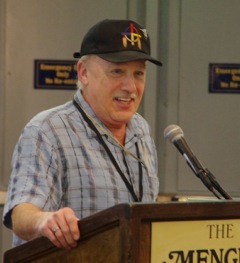Thanks to fracking, North Dakota is now the second largest oil producer in the nation. Drilling and maintaining its roughly 8,000 wells has brought revenue and low unemployment rates to the state. At the same time, some residents worry that it is damaging the environment and contaminating water supplies, threating the health of residents.
In this high stakes debate there is an obvious need for reliable information on the risks of fracking. Yet surprising little independent research is conducted and—some argue—findings damaging to the oil industry are not being released.
In North Dakota, Dr. Kerry Hartman, professor of environmental science at Fort Berthold Community College, is one of the few scientists not affiliated with the oil industry or federal government to examine the impact of fracking in the region.
The college is located on the Fort Berthold Reservation of central North Dakota, which now has one of the highest concentrations of wells in the state.
In a recent research project, Hartman collected samples from water wells and sent them to government labs, looking for evidence of contamination by fracking fluids. However, he was surprised when the lab stopped analyzing his samples and would not release findings from the samples it did test.
In the following Q and A, Hartman discusses his project and the unexpected barriers he faced. He began the conversation with Native Science Report Editor Paul Boyer by emphasizing that he was not representing the college. “These are my views as a professor and as a scientist,” he said. “My opinions are my own.”
Boyer: Can we begin by summarizing the extent of fracking on the Fort Berthold Reservation?
Hartman: There are hundreds of wells that have been fracked within the boundaries of the Fort Berthold Reservation. Of course, it’s fluid. It increases every day–although it has slowed down greatly in recent months.
Boyer: As a scientist, can you summarize the concerns over fracking?
Hartman: One major area of concern is water, of course. The process uses three to five million gallons of fresh water and brings back two to four million gallons of extremely polluted water. Much of the pollutant is in the form of salt—natural anions and cations [negatively and positively charged ions]. But there’s also much controversy over the substances added to the fracking fluid, ranging from diesel to benzene.
Much of this effluent water is transported across the surface, primarily by trucks and pipelines. This can result in spills. There was another huge spill—60,000 gallons—by Powers Lake recently.
Connected to this is the issue of groundwater. In our research, we detected leakage of these fracking fluids in to the aquifer. They say it’s not possible because precautions are taken. Well, the precautions are designed by humans, and mistakes are made.
Boyer: Tell me more about your research, testing water samples from water wells on the reservation.
Hartman: We followed a quality assurance project plan that was approved by the EPA. It included many pages of procedure–how to stabilize the source, take the sample, preserve the sample, and mail the sample with signatures at both ends. We followed the procedure to the letter.
Of course we’re humans, so we may have made a mistake here and there, but by and large our quality assurance project plan was the same one that was developed by a team of scientists by the EPA for a similar study they were conducting near Kill Deer.
The samples were sent to EPA-approved labs for analysis. There were eleven or twelve bottles per well, using different types of preservatives. Also, different types of bottles were used for each well. We sampled eleven or twelve wells from the first load and an additional seven for the second load, so we had large, 30 gallon coolers filled with bottles. These were shipped by UPS to EPA labs in Golden, Colorado and Aida, Oklahoma.
They processed the samples from the first two loads. At the beginning of the third load, I was told they had been ordered to stop processing my samples.
Boyer: Why did the lab stop testing your water samples?
Hartman: I was told by a lab tech, who will remain anonymous, that they “found something.” But he could not say more and he said he wasn’t supposed to have told me that. I made multiple attempts to multiple officials in the EPA at various levels and never got an acceptable answer.
I did get a totally bogus answer why they had stopped analyzing my results. They said it was because they wanted me to invent a better quality assurance plan, which I scoffed at since I was following the EPA’s own plan, which was developed by a team of credible scientists. I thought that was pure baloney.
That was the reason they gave me for why they stopped the project, after they had funded it and agreed to proceed with it, and approved the quality assurance plan, and volunteered their own labs. All of a sudden they stopped. I was never given an adequate explanation.
Boyer: Are you the only one doing this kind of research and analysis, and making findings public?
Hartman: To my knowledge. I’m copying a project the EPA is doing, but to my knowledge, they have not released their findings yet, which makes me wonder what they found. And in this area, I think it’s true that I am one of a select few—although there are lots of people studying the impacts of fracking across the country.
Boyer: What is the next step?
Hartman: We’re planning to continue the project and retest those wells, probably this summer. We’ll probably have to go with a commercial lab.

